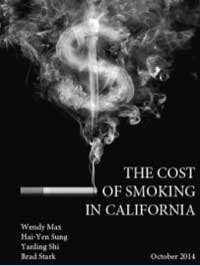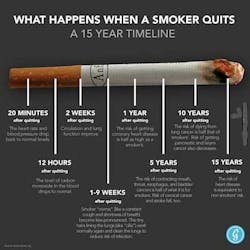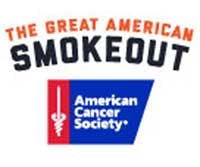About 14 million major medical conditions in the U.S. can be attributed to smoking. Using surveys, researchers found that in 2009 approximately seven million Americans reported almost 11 million major medical conditions caused by smoking.(1) If you include illnesses people are not aware they have, or have not reported, that number rises to 14 million medical conditions.
Chronic obstructive pulmonary disease (COPD) was the most commonly reported condition, with 4.3 million cases, followed by 2.3 million heart attacks, 1.8 million cases of diabetes, 1.1 million strokes, and over 1 million cases of smoking-related cancers.(1) As we know, other cancers that can be connected to smoking and tobacco use occur in the bladder, cervix, colon, esophagus, kidney, larynx, windpipe, mouth, tongue, lip, and throat.
He goes on to say that smoking is the most common cause of preventable death in the United States and worldwide. While the prevalence rates are decreasing, there are still many smokers. The reasons for that are many, from lack of funding for prevention and programs and no advocacy movements, to inconsistent intervention by health care professionals. Read the article and commentary to understand the problems we’re facing as a nation.(1, 2)
In other news, a study reveals a significant link between use of tobacco and infection with oral papillomavirus type 16 (HPV16).(3) HPV16 is a sexually transmitted organism and has been connected to oropharyngeal squamous cell cancers. In the study, researchers established a strong association between tobacco use or exposure and infection with the oral human papillomavirus type 16. HPV16 infection is more common among those who have recently been exposed to or used tobacco, regardless of their sexual behavior. While not 100% sure why this link exists, researchers postulate that smokers may not totally rid their bodies of the virus, or may engage in activities that increase their risk. This is one more reason to actively engage in smoking cessation counseling!
We are aware that smoking costs money, in addition to lives. This is directly caused by the addiction and the diseases it causes, as well as by the premature deaths of smokers and others. Smoking and other tobacco use affects communities and individuals in many costly ways. Read the new report “The Cost of Smoking in California” for more information. Here is an excerpt from the report: “There were 34,363 deaths attributable to smoking in 2009,17 times more than the number from AIDS; five times the deaths from diabetes, influenza and pneumonia; and three times the number of deaths from Alzheimer's disease and unintentional injuries.”(4)
In research from other parts of the country, the American Journal of Public Health reports that direct mail from tobacco companies to consumers is associated with developing smoking habits among non-smokers and relapse smoking among ex-smokers. Among baseline nonsmokers and ex-smokers, receiving coupons was associated with becoming current smokers at the follow-up intervention. Among baseline current smokers, receiving coupons was associated with a lower likelihood of smoking cessation at follow-up. The conclusions are that tobacco direct mail marketing promoted and sustained smoking behaviors among U.S. Midwest young adults. The authors suggest that regulating this marketing strategy could reduce the incidence of smoking in this population.(5)
Reports have confirmed that smoking while pregnant or around an infant cause many adverse events, such as the development of asthma and allergies in young children. However, researchers recently found that the risk may persist into the teen years. The scientists examined the role of prenatal and postnatal second-hand tobacco smoke (SHS) exposure on asthma, rhinitis, and eczema development up to 16 years of age. They found that early SHS exposure, in utero or during infancy, affects the development of allergic disease up to adolescence. Additional risks for asthma and rhinitis were seen primarily in early childhood, whereas those for eczema occurred at later ages. The study found an association, but was not designed to show a cause-and-effect relationship. A strength of the study is the large number of children and the long-term follow-up.(6)
While most people smoke tobacco cigarettes, some prefer to smoke marijuana. Marijuana use is legal in some states for medicinal or recreational purposes. Dental hygienists and other health professionals should understand the oral health implications of its use.
Helping to stop the tobacco epidemic can save lives and money. It is never too late. For tools to help in this endeavor, visit the Smoking Cessation Leadership Center website. Smokers need help from us, health professionals, whose advice is a powerful motivator.(9)
Maria Perno Goldie, RDH, MS, is the editorial director of RDH eVillage FOCUS.
References
1. Rostron BL, Chang CM, Pechacek TF. Estimation of Cigarette Smoking–Attributable Morbidity in the United States. JAMA Intern Med. Published online October 13, 2014. http://archinte.jamanetwork.com/article.aspx?articleid=1915870.
2. Schroeder SA. Even More Illness Caused by Smoking Than Previously Estimated. Invited Commentary. JAMA Intern Med. Published online October 13, 2014. http://archinte.jamanetwork.com/article.aspx?articleid=1915869&resultClick=3.
3. Fakhry C, Gillison ML, D’Souza G. Tobacco Use and Oral HPV-16 Infection. JAMA. 2014; 312(14):1465-1467.
4. Max W, Sung HY, Shi Y, Stark B. The Cost of Smoking in California, 2009. San Francisco, CA: Institute for Health & Aging, University of California, San Francisco, 2014.
5. Choi K, Forster JL. Frequency and characteristics associated with exposure to tobacco direct mail marketing and its prospective effect on smoking behaviors among young adults from the U.S. Midwest. Am J Public Health. 2014 Nov; 104(11): 2179-83.
6. Thacher JD, Gruzieva O, Pershagen G, et al. Pre- and Postnatal Exposure to Parental Smoking and Allergic Disease Through Adolescence. Pediatrics 2014; 134:3 428-434; published ahead of print August 18, 2014, doi:10.1542/peds.2014-0427.
7. Thomson WM, Poulton R, Broadbent JM, et al. Cannabis smoking and periodontal disease among young adults. JAMA. 2008 Feb 6; 299(5):525-31. doi: 10.1001/jama.299.5.525.
8. http://www.cancer.gov/cancertopics/pdq/cam/cannabis/healthprofessional/page5.
9. http://smokingcessationleadership.ucsf.edu/.
10. http://www.cancer.org/healthy/stayawayfromtobacco/greatamericansmokeout/index.












